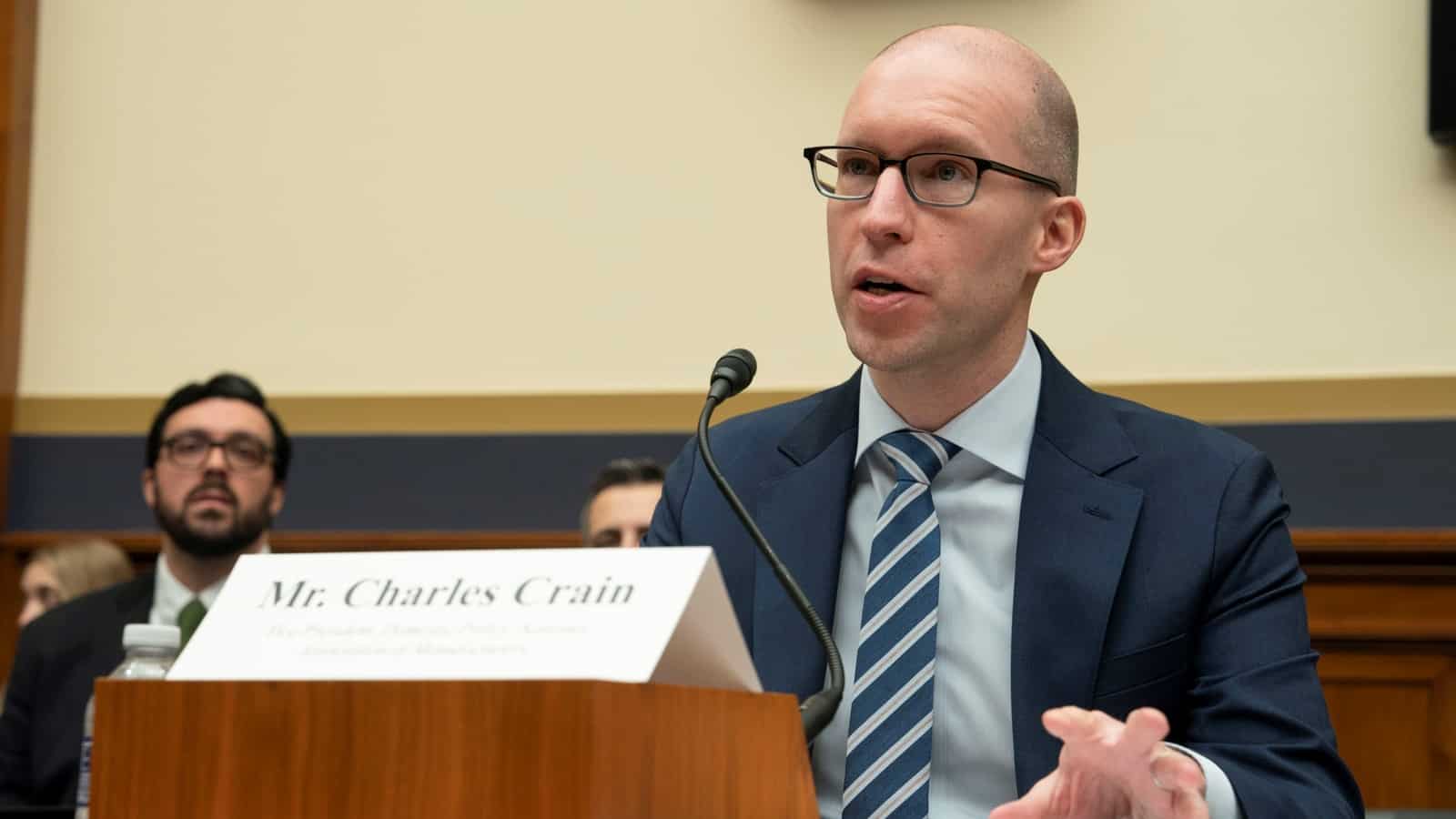Manufacturers: New EPA Rule Directly Undermines President’s Manufacturing Agenda
Washington, D.C. – Following the decision by the Environmental Protection Agency to lower the National Ambient Air Quality Standards for fine particulate matter (PM2.5) to 9 micrograms per cubic meter, National Association of Manufacturers President and CEO Jay Timmons released the following statement:
“The Biden administration’s new PM2.5 standard takes direct aim at manufacturing investment and job creation, in direct contradiction to the president’s stated goal of strengthening manufacturing in communities all across America.
“The new standard of 9 and the EPA’s paltry 60-day implementation window will guarantee projects currently under permitting review will have to comply with this onerous decision, making an already gridlocked permitting system further gridlocked.
“Manufacturers in America will also be hard pressed to make long-term investment plans domestically as our global competitors have set more reasonable goals. The EU standard is currently 25, and a proposal there would be to reach 10 by 2030. The UK has a target of 10 by 2040.
“Governors and mayors will now have to make difficult decisions under this untenable standard. New manufacturing investments envisioned by the CHIPS and Science Act, the Bipartisan Infrastructure Law and the energy provisions of the Inflation Reduction Act will be subject to these new requirements. This revised standard will force some communities to choose which—if any—investments can proceed without running afoul of the EPA’s decree.
“By implementing such a radical standard here, our country is ceding our competitive advantage with an unforced error. All of these choices could have been avoided with a more sensible standard and a longer implementation runway.
“The EPA itself says that some 70% of particulate matter comes from nonmanufacturing sources, such as wildfires (29%), agriculture and prescribed fires (15%), crop and livestock dust (12%), unpaved road dust (10%), paved road dust (3%) and “dust” (2%). Before forcing actions that will curtail manufacturing investment and infrastructure development, the federal government should first determine how to deal with what is occurring naturally.
“To be sure, manufacturers proudly stood up for funding in the Bipartisan Infrastructure Law, CHIPS and Science Act investments and many of the policy provisions outlined in the IRA. But there is no doubt that our country will be unable to realize the benefits of these legislative accomplishments with this new rule in place. As counties and cities find themselves in nonattainment, this grave mistake will drive investment away from the United States, derail permitting and weaken the economy for all.
“The U.S. already has some of the strictest air standards in the world, and thanks to manufacturers’ innovation and leadership, some of the cleanest air and best environmental records. Manufacturers will consider all options to reverse this harmful and unnecessary standard, because it is our duty to stand against policies that hold our country back.”
Background:
Per the EPA: Nonattainment is any area that does not meet (or that contributes to ambient air quality in a nearby area that does not meet) the national primary or secondary ambient air quality standard for NAAQS.
The EPA recently reported that PM2.5 concentrations have declined by 42% since 2000, driven by major emissions reductions from both mobile sources and the power sector. As a result, America’s air is cleaner than ever.
-NAM-
The National Association of Manufacturers is the largest manufacturing association in the United States, representing small and large manufacturers in every industrial sector and in all 50 states. Manufacturing employs nearly 13 million men and women, contributes $2.85 trillion to the U.S. economy annually and accounts for 53% of private-sector research and development. The NAM is the powerful voice of the manufacturing community and the leading advocate for a policy agenda that helps manufacturers compete in the global economy and create jobs across the United States. For more information about the NAM or to follow us on Twitter and Facebook, please visit www.nam.org.
NAM to Congress: SEC Must Fix Flawed Climate-Reporting Rule

The Securities and Exchange Commission’s pending climate disclosure rule would place an enormous, untenable burden on manufacturers—and impose a disproportionate hardship on small businesses, NAM Vice President of Domestic Policy Charles Crain told lawmakers Thursday.
What’s going on: Crain gave testimony before the House Financial Services Subcommittee on Oversight and Investigations on the damaging effects of the SEC’s proposed climate rule, which would require businesses to reveal large amounts of convoluted (and often sensitive) climate-related data.
- The plan would force disclosure of so-called “Scope 3” emissions—those that come from companies’ supply chains—and institute new climate-related accounting requirements, among other mandates.
Why it’s a problem: If finalized, the rule would divert funds from manufacturing growth, including at small manufacturers.
- “Manufacturing pioneers groundbreaking technologies, including the innovations necessary to combat climate change,” Crain said. “The rule would impose tremendous costs on manufacturers of all sizes—while overwhelming investors with immaterial information. And the SEC hasn’t done the work to show that the rule’s benefits outweigh its costs, or that the rule is even within the SEC’s legal authority.”
- The proposed regulation would, by the agency’s own accounting, “raise the cost to businesses of complying with its overall disclosure rules to $10.2 billion from $3.9 billion, an additional cost of about $530,000 a year for a bigger business,” according to The Wall Street Journal (subscription).
Costs to manufacturers: Crain told lawmakers that the SEC’s analysis likely understates the true costs of the rule, in part because the agency did not consider the impacts on private businesses.
- “For the larger companies subject to [the Scope 3] requirement, the SEC has admitted that it cannot ‘fully and accurately quantify’ the costs,” Crain said. “But for the small businesses that are swept into large companies’ Scope 3 efforts, the SEC hasn’t even tried. The SEC’s proposal does not include any discussion of the Scope 3 costs that will fall on small and private businesses.”
- Crain warned lawmakers that these compliance costs would represent a “huge resource diversion” for small manufacturers.
Regulatory onslaught: Crain shared the NAM’s landmark Cost of Federal Regulations study with lawmakers, explaining that the SEC’s proposal would add to the $50,000-per-employee-per-year regulatory burden small manufacturers face.
- “The SEC’s climate rule is at the center of this regulatory onslaught,” Crain said.
NAM in the news: Bloomberg (subscription), Law360 and Pensions & Investments all covered the NAM’s testimony.
Norway Approves Deep-Sea Mining

Norway voted Tuesday to open its waters to deep-sea mining, the process of harvesting valuable metals from the ocean floor, CNBC reports.
What’s going on: Having approved a government proposal Tuesday to allow exploration in its waters, “Norway is poised to become one of the first countries in the world” to allow deep-sea mining.
- The parliament formally agreed to allow exploration of just more than 108,000 square miles of Arctic seabed between Norway and Greenland.
- Companies will be required to “submit proposals for licenses,” which will be granted on a case-by-case basis.
Why it’s important: “Advocates say removing metals and minerals from the ocean’s seabed is necessary to facilitate a global transition away from fossil fuels,” CNBC reports.
- Many of the critical minerals needed for electric vehicles—including cobalt, copper and nickel—are present in large quantities on the seafloor.
- The move by Norway sets it apart from the United Kingdom and the European Union, “which have pushed for a temporary ban” on deep-sea mining, citing environmental concerns.
- In the U.S. last year, lawmakers introduced legislation calling for a deep-sea mining moratorium pending further research into the method’s environmental impacts, according to Honolulu KHLN.
The NAM says: “Norway’s vote should be a wake-up call to the U.S. that other nations are doing everything possible to secure their own sources of critical minerals. We need to do the same,” said NAM Vice President of Domestic Policy Brandon Farris. “That means first reforming our antiquated permitting system.”
NAM Pushes Back on Restrictive Chemical Rule

The Environmental Protection Agency is considering an effective ban of a chemical compound called ethylene oxide. However, abruptly eliminating the chemical from use could have profound negative consequences for manufacturers and make modern life much more difficult.
The background: Ethylene oxide is a chemical used in a wide range of products, from textiles to plastics to antifreeze. It’s also used to sterilize certain medical devices—and in some cases, it’s the only chemical effective for that purpose.
The problem: The EPA is considering a new regulation that would set the acceptable levels of the chemical in the atmosphere so low that it amounts to a ban on the compound.
- “If you took a monitor outside in any U.S. city center, where no manufacturing production occurs, the level of ethylene oxide would be higher than the level the EPA is proposing,” said NAM Vice President of Domestic Policy Brandon Farris.
- “So anywhere that manufactures or uses ethylene oxide would be above the level they’re suggesting. The EPA is effectively banning it by creating a level that’s so low it can’t possibly be met.”
The impact: Because there are no current substitutes for some uses of ethylene oxide, a de facto ban would have immediate and serious impacts.
- “If this rule is finalized, a large number of medical devices could no longer be sterilized, and a lot of items that are relied on for modern life, such as textiles, plastics, household cleaners and adhesives, could not be produced in their current form,” said Farris. “If the EPA moves forward with this proposal, there will be no alternatives for the critical uses of this compound.”
The timeline: The final rule is expected to be released in the next few months. If the EPA chooses to finalize the rule in its current form—which would create a de facto ban on production and usage—manufacturers would be required to find a replacement for the chemical immediately. Developing a replacement in such a short amount of time will be difficult if not impossible.
Read the full story here.
Why the SEC’s Climate Rule Won’t Work

Next on our list of misguided, burdensome regulations is a Securities and Exchange Commission misstep: climate rules that would force manufacturers to meet impossible deadlines and disclose sensitive information, without doing anything to protect investors.
The background: Last year, the SEC proposed a new rule that would require companies to disclose a massive amount of information, much of it impractical to collect or immaterial to investors.
- First, the proposed rule requires qualitative descriptions of companies’ climate-related risks and any efforts to respond to those risks, including internal metrics and confidential strategies.
- Second, it mandates quantitative reporting of companies’ greenhouse gas emissions, while compelling companies to conduct quantitative climate impact analyses within their consolidated financial statements.
- The result? An unworkable framework that imposes uniform mandates that do not align with manufacturers’ efforts to respond to climate change—but do impose an enormous burden on manufacturers across the country.
The response: The NAM has laid out a series of necessary changes that the SEC must make to reduce compliance costs and limit liability risks associated with the rule’s requirements. Specifically, the NAM is calling on the SEC to do the following:
- Strike disclosure of Scope 3 emissions, which requires companies to track emissions data from suppliers and customers throughout the supply chain. While some manufacturers are already working to understand these emissions, the data collection, estimation and reporting methodologies are still evolving—and the proposed mandate could have a disproportionate impact on small businesses swept into the reporting regime.
- Rescind accounting changes that would require climate impact analyses of companies’ consolidated financial statements on a line-by-line basis.
- Delay annual GHG emissions reporting, granting manufacturers more time to collect and verify data.
- Adjust the climate-related risk disclosures and Scope 1 and Scope 2 emissions reporting requirements to make the provisions less prescriptive and more aligned with existing company practices.
- Fine-tune the guidelines for reporting on climate-related goals to avoid penalizing companies that set ambitious targets.
- Remove requirements that companies disclose competitively sensitive information about the internal tools they use to understand and plan for climate risks, scenarios and activities.
NAM in action: Since the SEC first unveiled this attempt at regulatory overreach, the NAM has been on the move.
- The NAM led more than 50 other manufacturing associations in a letter calling on Congress to insist that the SEC develop a more workable version of the rule.
- The NAM also urged Congress to exercise stricter oversight of the SEC, push back against the agency’s regulatory onslaught and ensure the SEC’s rules remain within the agency’s statutory authority.
- NAM President and CEO Jay Timmons made revising the climate rule a focal point of the NAM’s corporate finance agenda.
- And last, NAM Managing Vice President of Policy Chris Netram testified about the harms to small manufacturers that would result from the climate rule at a House Financial Services Committee hearing.
The last word: “Manufacturers are leaders in responding to climate change and in informing investors about this critical work, but the SEC’s climate rule is simply unworkable,” said NAM Vice President of Domestic Policy Charles Crain. “Given the complex nature of manufacturing supply chains, the rule’s costly mandates will have a disproportionate impact on our industry—and particularly on small manufacturers. The SEC must rescind, or at a minimum significantly revise, its overreaching and impractical proposal.”
New Regulations Could Hurt Competitiveness
Oppose Harmful Regulations
Take action
The NAM is leading the charge in urging the Biden administration to walk back a proposed revision to the National Ambient Air Quality Standards for fine particulate matter (PM2.5).
With the release of a letter signed by more than 70 associations representing nearly every sector of the U.S. economy and a new video advertisement, the NAM is highlighting how these regulatory actions would devastate the economy and actively undermine President Biden’s goal to expand manufacturing in the United States.
What’s going on: When the Environmental Protection Agency set forth the tentative new air quality standards earlier this year, manufacturers quickly recognized that if enacted, the new rules would put an undue burden on the industry—and could force companies to move operations overseas.
- Soon, manufacturers and related associations across the country began to speak out about the harm to their operations and communities, even as they affirmed the industry’s longstanding commitment to a clean, safe environment for all.
The background: The EPA’s proposed changes to the National Ambient Air Quality Standards—currently under review by the White House’s Office of Information and Regulatory Affairs— would lower the primary annual particulate matter standard from 12.0 µg/m3 to between 8.0 and 10.0 µg/m3.
- The EPA has estimated the total cost of the controls required for compliance with the proposed standard at up to $1.8 billion—and that figure could go higher, the agency admitted.
- What’s more, some areas in the U.S. are already in “nonattainment” with the current PM2.5 standard, so a stricter standard will only put them further away from compliance and economic growth.
The costs: According to an analysis by Oxford Analytics and commissioned by the NAM, the revisions would:
- Threaten nearly $200 billion of economic activity and put up to a million current jobs at risk, both directly from manufacturing and indirectly from supply chain spending;
- In addition, growth in restricted areas may be constrained, limiting investment and expansion over the coming years; if the PM2.5 standard moves to 8 from the current 12, nearly 40% of the country will live in nonattainment areas, putting jobs and livelihoods at risk as factories may no longer be able to operate if located in an area that is in nonattainment, and no new facilities can be built to grow economic prospects; and
- Hit California’s manufacturing sector hardest, followed by Michigan and Illinois.
Speaking out: Many manufacturers from all sectors, along with related associations, have made their concerns public.
- Michael Canty, president and CEO of Alloy Precision Technologies of Mentor, Ohio, pointed out that these regulations may force companies to move production to other countries that don’t care about emissions reductions, unlike the U.S.
- Mark Biel, CEO of the Chemical Industry Council of Illinois, also worries that this regulation could make his state less attractive for manufacturers, despite its many assets.
- Dawn Crandall, executive vice president of government relations for the Home Builders Association of Michigan, decried the potential knock-on effects for Michigan’s suffering housing market.
The last word: The proposed changes “would risk jobs and livelihoods by making it even more difficult to obtain permits for new factories, facilities and infrastructure to power economic growth,” leadership from approximately 70 industry groups told White House Chief of Staff Jeffrey Zients yesterday.
- The revisions “would also threaten successful implementation of the Infrastructure Investment and Jobs Act, the CHIPS and Science Act and the important clean energy provisions of the Inflation Reduction Act. … We urge you to ensure the EPA maintains the existing fine particulate matter standards to [safeguard] both continued environmental protection and economic growth.”
Environmental Firm Langan Takes on ‘Forever Chemicals’

The race to remove PFAS from its remaining industry uses is on—and according to Langan’s Stewart Abrams, must be “a sprint, not a jog.”
In high demand: Abrams is a principal and director of remediation technology at Langan, a national environmental and engineering firm. He leads the consulting firm’s remediation practice, specializing in the treatment of perfluoroalkyl and polyfluoroalkyl substances, chemical compounds that were used widely in household products—including fire extinguishers—for decades.
- It’s an area of expertise that will soon be highly sought after, given the Environmental Protection Agency’s proposal earlier this year of drinking water maximum contaminant levels (MCL) of 4 parts per trillion (ppt) for both PFOA and PFOS. This will not only affect drinking water but will become an important standard for remediation sites as well.
- Langan has clients—including property owners and developers—who focus on the removal of PFAS from contaminated groundwater.
“What’s possible”: “Part of what Langan is doing is focusing on what is possible” regarding PFAS removal, Abrams said.
- “We’re looking at the treatment of groundwater and drinking water. We’re also working on how to deliver existing and new technologies to site cleanup. We’re going to have to move faster than ever before to bring these technologies to the marketplace. It’s a sprint, not a jog.”
Land remediation: Langan has long worked with property developers, helping them clear land of contaminants before building begins. PFAS issues, however, have changed the game considerably.
- “Now we’re looking at projects [for clients] where the question is, ‘How do you use water or land that’s been PFAS-contaminated?’” Abrams said.
- “Some companies have legacy contamination at the sites” they want to build on, and solutions aren’t always forthcoming, he continued.
Airports and PFAS: Another significant Langan customer sector? The aviation industry. Since 2022, airlines operating at California airports may no longer use PFAS in firefighting foam, a common use of the compounds for many years owing to their fire-extinguishing capabilities.
- “They’ve had to adopt new methods of firefighting at [California] airports,” said Abrams of Langan’s aviation clients in that state. “It’s hard because you need a lot of this fluid to address a fire given the amount of fuel on an airplane. The problem is that often the large water reservoirs at these airports have until recently contained a lot of PFAS.”
- That contamination isn’t limited to the water, Abrams added, but extends to everything the PFAS has touched. “Everything in the [firefighting] systems—the pumps, the nozzles, the piping—are contaminated, as is the storage reservoir itself. Part of the complexity of removal is cleaning all of it and then finding an alternative” surfactant, a chemical compound that can effectively extinguish fire.
- In addition, the sponge-like concrete that often lines the reservoirs at airports may have absorbed the chemical, requiring removal and replacement.
Finding solutions: About a decade ago, Langan and the New Jersey Institute of Technology began an informal research partnership.
- Members of Langan’s staff have access to NJIT’s environmental engineering laboratories, where they can set up experiments to solve client challenges. Now the company is leveraging that relationship to find solutions to PFAS problems.
- The labs are “a great [place] to bring in new ways of doing things with PFAS,” Abrams told us. “We’re exploring new treatment methods, new characterization methods, and we will be working to accelerate those technologies to market.”
Taking practical action: The strong carbon-fluorine bonds in PFAS chemicals render them harder to destroy than other contaminants, Abrams noted.
- “Unlike with other compounds—particularly volatile organic compounds and chlorinated solvents—with PFAS, we can’t quite track down all of it,” he continued. “It’s out there in the environment; it would be extremely difficult to chase down every molecule. Instead, we want to bring a theme of pragmatism to PFAS cleanup.”
Michigan Homebuilders Push Back on Air Quality Proposal

“Policy can’t be developed in a vacuum,” says Dawn Crandall, executive vice president of government relations for the Home Builders Association of Michigan. “People need to look at how one policy impacts that next thing. Everything is tied together.”
That’s Crandall’s message for the Environmental Protection Agency, as it considers a proposed air quality rule to restrict particles called PM2.5. While the regulations might not appear to impact the housing industry directly, they could prevent manufacturers from expanding facilities and creating jobs in Michigan—which does affect the housing market.
The concern: If manufacturers are unable to grow in the state or open new facilities, fewer people will need housing. That’s bad news for homebuilders.
- “If you put in these EPA regulations that are going to create a barrier for companies looking to move here, and then they decide they don’t want to, that’s going to impact Michigan’s ability to be an economic destination,” said Crandall.
- “And if you make it harder for businesses to employ employees, then they don’t need housing. That has a big impact on us.”
A shaky foundation: Michigan’s housing industry is still recovering from the significant downturn it experienced about 15 years ago.
- That slump was dramatic: according to Crandall, the number of permits filed in Michigan for single-family homes fell sharply from 54,721 in 2005 to around 15,000 two years later, bottoming out to about 6,900 in 2009.
- Although the industry has seen some recovery since then, new construction remains relatively low, and Crandall worries that shocks caused by the EPA’s proposed regulations could do further harm.
- “I think we’ve hit rock bottom, and we’re slowly coming out of it,” said Crandall. “But we’re only projecting 16,000 single-family permit builds this year—and anything that’s going to impact residential construction is not good for the state of Michigan.”
Another challenge: Ultimately, Crandall is concerned that the EPA’s proposed rule will simply add to a long list of challenges for homebuilders.
- “We’re already facing enough hurdles,” said Crandall. “There’s a lack of skilled workers who can do residential construction. Material costs peaked during COVID. We get a lot of our lumber from Canada, so these Canadian wildfires could have an impact. So if PM2.5 is going to affect economic development in our state, that’s going to have an impact on us, too.”
The big idea: “We’re all connected in some form or fashion,” said Crandall. “Michigan needs to grow our population, and we can’t do that if companies don’t bring people into our state who want to live, work and play here. We’re one big ecosystem.”
Illinois Chemical Industry Warns Against New EPA Standard

The chemical industry has a wide reach. According to Mark Biel, CEO of the Chemical Industry Council of Illinois, 96% of products made in the United States are either manufactured by the chemical industry itself or using materials it produces.
- “We make everything from cell phones to packaging,” said Biel. “People don’t realize the integral role that chemistry plays in their lives.”
And for Illinois in particular, the chemical industry isn’t just making products—it’s making careers.
- “Our state has 46,000 people in the chemical industry, and the average wage is a little over $114,000,” said Biel. “We are the second largest manufacturing sector in Illinois, which is the fourth largest chemical processing state. Folks don’t realize how large and important the chemical industry is to Illinois.”
But as the Environmental Protection Agency considers imposing a new, stricter air quality standard for particles called PM2.5, chemical manufacturers in Illinois are sounding the alarm. According to Biel, the new regulations misunderstand the situation—and threaten to cause irreparable harm for manufacturers across the state.
The background: Manufacturers have long been committed to reducing particulates in the air, including PM2.5, and have made huge strides over the past half-century. But to further reduce PM2.5 will be a tall order.
- “We should be focused on enforcing the regulations we already have in the books,” said Biel. “The U.S. already has strong regulations in place—ones that many areas are still working to meet. Let us be smart about new regulations, which means we should not change air permitting before meeting current standards.”
The local angle: For the chemical industry in Illinois, the changes could be particularly damaging.
- With access to waterways, relatively inexpensive electricity and extensive natural gas pipeline infrastructure, the St. Louis and Chicagoland areas of Illinois are hubs for the national chemical industry.
- However, if the EPA’s standards become stricter, it could deter investments to these metro areas significantly.
- “It’s difficult enough to permit a new facility in the Chicagoland area, and when you throw on additional burdens, it makes it harder and harder to justify making the investment in these facilities,” said Biel.
The global stage: Especially at a time when many manufacturers are looking for ways to bring investments and supply chains back to the United States, this kind of onerous regulation could create a stumbling block.
- “Our lawmakers want manufacturing to come back to the U.S., but this regulation does the exact opposite,” said Biel. “With all the new investment, it’s important that more and more manufacturers locate in the U.S. to avoid supply chain complications and delays. This regulation hinders that development.”
The last word: “I’m bullish on the long-term prospects for our industry, but sometimes the EPA loses sight of the reality that their regulations are already sufficient,” said Biel. “The current PM2.5 standard has worked. But this proposal goes far beyond that and will hinder a crucial opportunity for the industry to grow in the U.S.”
Manufacturers: Lowering Particulate Matter Standard Would Harm Infrastructure Investment
Washington, D.C. – Following a request from White House Environmental Justice Advisory Council Chair Brenda Mallory asking the Environmental Protection Agency to lower the annual primary standard for particulate matter (PM2.5) to 8.0 μg/m3 and to lower the primary 24-hour standard to 25.0 μg/m3, National Association of Manufacturers Vice President of Domestic Economic Policy Brandon Farris released the following statement:
“Moving the PM2.5 standard all the way down to 8.0 μg/m3 as the White House Environmental Justice Advisory Council suggested means 40% of the U.S. population will live in an area considered ‘out of attainment,’ essentially halting construction on bridges, roads, manufacturing facilities and agriculture projects in areas that desperately need development.
“Manufacturing in the U.S. is already among the cleanest in the world, and we don’t have to make a choice between cleaner air and economic prosperity. The EPA can choose both by finalizing a reasonable standard that doesn’t thrust much of the country into an area where no growth can happen.
Background: A new report conducted by Oxford Economics and commissioned by the NAM warns that the EPA’s proposed air quality regulations for PM2.5 could threaten $162.4 billion to $197.4 billion of economic activity and put 852,100 to 973,900 jobs at risk, both directly from manufacturing and indirectly from supply chain spending. In addition, growth in restricted areas may be constrained, limiting investment and expansion over the coming years. Due to these limited opportunities for expansion or investment, these areas in nonattainment could lose out on an additional $138.4 billion in output and 501,000 jobs through 2027.
-NAM-
The National Association of Manufacturers is the largest manufacturing association in the United States, representing small and large manufacturers in every industrial sector and in all 50 states. Manufacturing employs nearly 13 million men and women, contributes $2.91 trillion to the U.S. economy annually and accounts for 55% of private-sector research and development. The NAM is the powerful voice of the manufacturing community and the leading advocate for a policy agenda that helps manufacturers compete in the global economy and create jobs across the United States. For more information about the NAM or to follow us on Twitter and Facebook, please visit www.nam.org.
